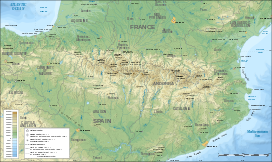Pica d'Estats
Pica d'Estats (Catalan and Spanish: Pica d'Estats, French: Pic d'Estats) is a 3,143-m-high mountain in the Montcalm Massif, Pyrenees.[1] on the Spanish–French border.
| Pica d'Estats | |
|---|---|
| Pic d'Estats | |
 | |
| Highest point | |
| Elevation | 3,143 m (10,312 ft) |
| Prominence | 1,277 m (4,190 ft) |
| Coordinates | 42°40′02″N 01°23′50″E / 42.66722°N 1.39722°E |
| Geography | |
| Location | Pallars Sobirà, Spain Ariège, France |
| Parent range | Pyrenees |
| Climbing | |
| First ascent | 1864 by Henry Russell and Jean-Jacques Denjean |
In France, it is the highest point in the Department of Ariège. In Spain, it is the highest point of the autonomous community of Catalonia and of the province of Lleida.[2]
Geography
changeThe summit of this mountain is on the border of the Regional Natural Park of the Pyrenees of Ariége (French: Parc naturel régional Pyrénées Ariègeoises).[3] The Pica d'Estats is in a group of mountains that forms the Massif du Montcalm, and is the highest of the mountains in the East-Central Pyrennes.[2]
The summit has three peaks, all very close to each other:
- Central peak, or Pica d'Estats, ( 3,143 m)[4]
- Western peak, or Pic de Verdaguer, (3,131 m)
- Eastern peak, or Punta Gabarró, (3,115 m); here there is a triangulation station.
The group of three peaks runs north-northwest to southeast along the Spanish–French border.
Geologie
changeThe summit of Pica d'Estats is made of granite.
Climate
changeEven with its altitude, the Pica d'Estats does not have much snow.
History
changeThe first ascent of this peak was made by Corabœuf & Jean-Jacques Testu in 1827.[5] Henry Russell climbed this peak in June 1864.[6][N 1]
Notes
change- ↑ Many articles (see other Wikipedias) say that Henry Russell climbed the peak together with his French guide Jean-Jacques Denjean but Russell wrote that Denjean stayed sleeping in a house and that he went up to Pica d'Estats with the owner of the house, an unknown "young man". In the same pages, he wrote that he had visited the region seven or eight years before but he did not say if he visited d'Estats at that time.
References
change- ↑ "Mapa Topogràfic de Catalunya". Institut Cartogràfic de Catalunya. Retrieved 31 July 2013..
- ↑ 2.0 2.1 "Pic d'Estats, France/Spain". Peakbagger.com. Retrieved 31 July 2013.
- ↑ "Plan du Parc interactif". Parc naturel régional Pyrénées Ariégeoises (in French). Archived from the original on 9 June 2011. Retrieved 31 July 2013.
- ↑ "Track and description"..
- ↑ "Historique et chronologie des "premières" pyrénéennes". Henry Russell-Killoug - Comte des Pyrénées (in French). Retrieved 31 July 2013.
- ↑ Russell, Comte Henry (1878). Souvenirs d'un montagnard (in French). Pau: Imprimérie Vignancour. pp. 116–127. Retrieved 1 August 2013.
Other websites
change- (in French) Altituderando: Pic du Montcalm - Pic d'Estats - Pic Verdaguer
- (in French) Camptocamp.org
